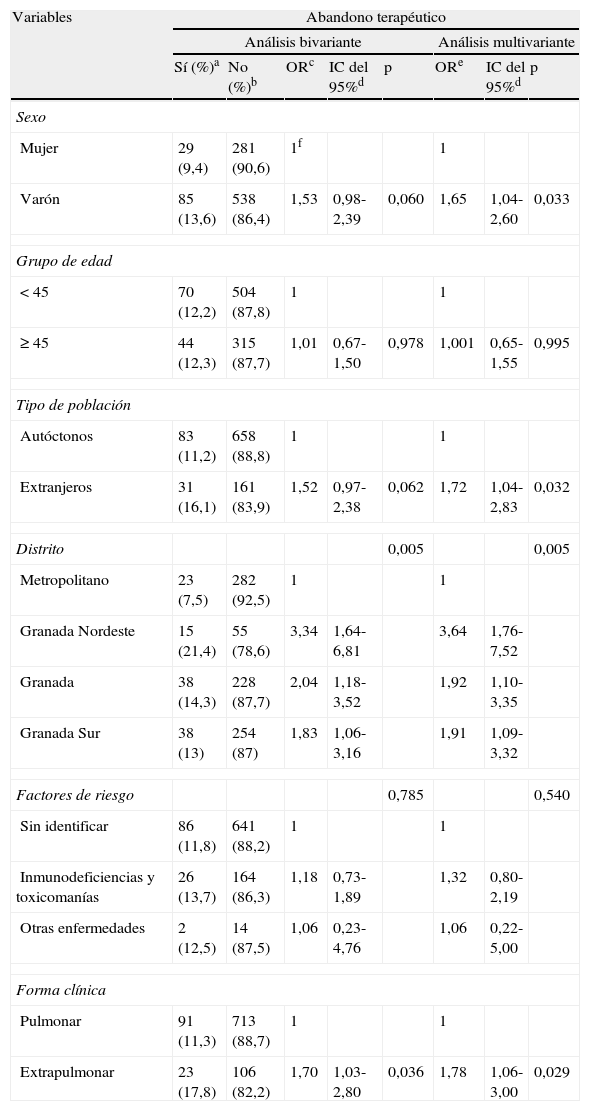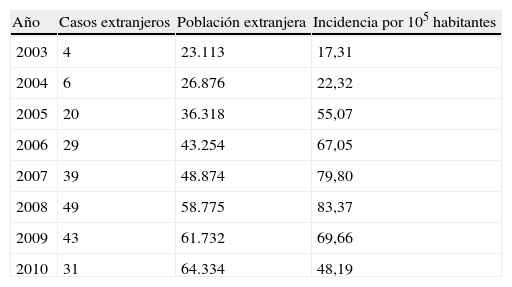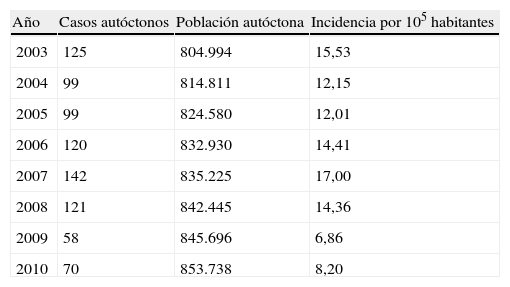Los factores asociados al abandono del tratamiento de la tuberculosis (TBC) pueden ser muy específicos de la población y de la organización sanitaria locales. Hemos examinado los factores asociados al abandono del tratamiento de la TBC en la provincia de Granada.
Sujetos y métodosCohorte retrospectiva de los casos registrados en Granada y notificados en el Sistema de Vigilancia Epidemiológica de Andalucía durante los años 2003-2010. Se calculó la incidencia en la población nacional y extranjera. Se realizó un análisis univariante para describir las características en ambos colectivos y se creó un modelo de regresión logística para identificar los factores asociados al abandono terapéutico.
ResultadosObservamos una tendencia decreciente en la incidencia de TBC (20,47 casos en el año 2007 y 11,00 en el 2010 por 100.000 habitantes; tasa de descenso de 9,47 casos por 100.000 habitantes). La edad media de los pacientes extranjeros fue menor que la de los enfermos nacionales (30,8 años vs 46,0 años; p<0,001). Los primeros residían de forma predominante en el distrito Granada, mientras que los nacionales habitaban en el distrito Metropolitano. El porcentaje de pacientes que abandonaron el tratamiento antituberculoso fue del 12,2% y fue algo superior en los enfermos extranjeros que entre los nacionales (14 vs 10%; p=0,062). Ser varón (OR: 1,65; IC del 95%: 1,04-2,60; p=0,033), extranjero (OR: 1,72; IC del 95%: 1,04-2,83; p=0,032), residente en el distrito Nordeste (OR: 3,64; IC del 95%: 1,76-7,52; p=0,005) y/o padecer TBC extrapulmonar (OR: 1,78; IC del 95%: 1,06-3,00; p=0,029) se asociaron de forma significativa con el abandono terapéutico.
ConclusionesLa incidencia de TBC en la provincia de Granada se ha reducido alrededor de 10 casos por 100.000 habitantes y año. El porcentaje de enfermos que abandonan el tratamiento TBC es considerable, siendo superior en los pacientes extranjeros que en los nacionales. El abandono del tratamiento TBC se asoció a ser varón, residir en el distrito Nordeste de Granada y padecer TBC extrapulmonar.
The factors associated to tuberculosis (TB) treatment drop-out can be very specific to the population and the local health care organization. We have studied the factors associated to TB treatment drop out in the province of Granada.
Subjects and methodsA retrospective cohort study of TB cases registered in the province of Granada by the Epidemiological Surveillance System of Andalusia (SVEA) between 2003 and 2010 was carried out. Incidence was calculated in the native and foreign population. An univariate analysis was performed to describe the characteristics in both groups and a logistic regression model was used to identify factors associated to therapeutic abandonment.
ResultsA decreasing trend in the incidence of TB was observed, (20.47 in 2007 to 11 cases per 100,000 inhabitants in 2010, respectively. Mean age of foreign patients was lower than that of the natives (30.8 years vs. 46.0 years, P<.001). The former predominately lived in the Granada district, while the natives lived in the Metropolitan district. The percentage of patients who abandoned antituberculous treatment was 12.2%, this being somewhat higher in the foreign patients than the national ones (14% vs 10%; P=.062). Being male (OR: 1.65; 95% CI: 1.04-2.60; P=.033), foreigner (OR: 1.72; 95% CI: 1.04-2.83; P=.032), resident in the North-east district (OR: 3.64; 95% CI: 1.76-7.52; P=.005) and/or having extrapulmonary TB (OR: 1.78; 95% CI: 1.06-3.00; P=.029) were associated significantly to therapeutic abandonment.
ConclusionsThe incidence of TB in the province of Granada has decreased to about 10 cases per 100,000 inhabitants/year. The percentage of patients who abandon TB treatment is significant, it being higher in foreign patients than in the natives. TB treatment abandonment was associated to being a man, living in the North-east district of Granada and having extrapulmonary TB.
Artículo
Diríjase desde aquí a la web de la >>>FESEMI<<< e inicie sesión mediante el formulario que se encuentra en la barra superior, pulsando sobre el candado.

Una vez autentificado, en la misma web de FESEMI, en el menú superior, elija la opción deseada.

>>>FESEMI<<<












